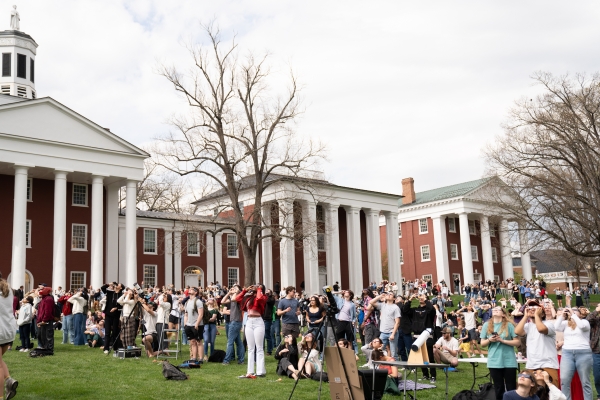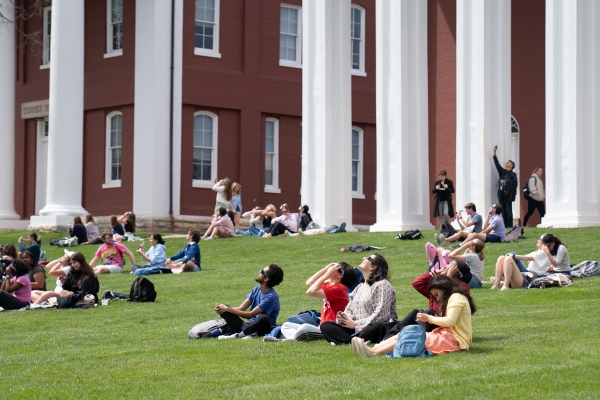Total Eclipsing on the Colonnade Hundreds of W&L students, faculty and staff came together to witness the astronomical event.

The gray cloud cover made it a game: Would the sliver of sun be visible from behind the moon and clouds during the eclipse? Hundreds of Washington and Lee University students, faculty and staff flocked to the Colonnade and the front lawn on Monday afternoon, April 8, to witness the 2024 total solar eclipse. In preparation for the big event, the W&L Physics and Engineering Department set up safe-viewing telescopes and binoculars with filters to reduce the intensity of the light and handed out solar glasses. Every time there was a break in the clouds, cheers erupted.
“[My favorite part is] the crowd,” said Chris Compton, laboratory technician and research specialist in the physics and engineering department who helped organize the event. “As soon as there’s a break in the clouds, you hear cheering and clapping from behind us. That makes me smile every time.”
Though April 8 marked the beginning of the last week of Winter Term classes, some professors canceled afternoon classes so students could take part in the solar eclipse, whose path of totality (when the moon completely blocks out the sun) stretched across Noth America from Mexico to Newfoundland. Lexington saw a partial eclipse at 87%, with maximum coverage at 3:16 p.m.

“It’s definitely lively,” said Nolan Rickett ’27. “This is the most populated the Colonnade has been since I’ve been here. It’s kind of interesting to see everyone out here for one big pause.”
With solar eclipse-inspired Oreos, students throwing footballs and kicking hacky sacks and a fair number of dogs joining the festivities, the viewing party united the campus in a stress-free moment before finals.
“It’s funny because I don’t think a lot of people knew this was going to be a big gathering,” said Bryn Bissinger ’26, “but everyone came out here.”
“I feel like it like brought the whole campus and community together,” agreed Sophie Berman ’26.
Burning Questions
Chris Compton, laboratory technician and research specialist in the physics and engineering department, shed some light on our questions:
What happens during a total solar eclipse?
During a total solar eclipse, the moon passes directly between the Earth and sun such that their discs overlap from our viewpoint. In Lexington, we saw a partial eclipse where the moon covered 87% of our view of the sun. Even with our partial eclipse, we experienced a dimming of daylight and a drop in temperature.

Why is this such a unique event?
This particular eclipse is unique as the path of totality was visible across a large swath of the United States from Texas to Maine.
How rare are these? When should we mark our calendars for the next one?
It turns out that total lunar eclipses are a little more rare than total solar eclipses. Total solar eclipses occur about every year and a half somewhere on the planet, and total lunar eclipses every 2.5 years. It feels special when totality passes over a populated area and can be seen easily rather than a remote area of an ocean.
The next total eclipse, globally, will occur Oct. 2, 2024, passing over parts of the Pacific Ocean and the southern tip of South America. The next total eclipse for the contiguous United States will be in August of 2044 and only visible in Montana and North Dakota, along with parts of western Canada.
What’s the most exciting part about events like this for you?
The spectacle of such an astronomical event and the excitement that comes with it are the best parts. We’ve understood the physics of planetary motion for centuries and the fact we can calculate down to the second when these events will occur for decades and centuries to come is an inspiring testament to scientific endeavors.

You must be logged in to post a comment.